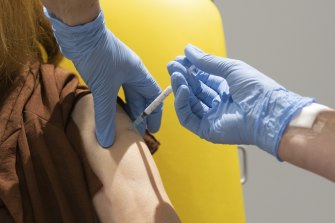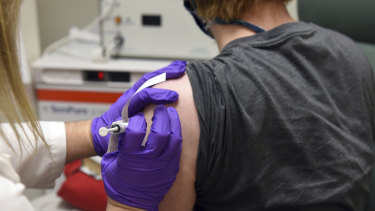A flurry of announcements over the past fortnight suggest we are about to get our hands on two very powerful vaccines against COVID-19 – and a third with more questions than answers.
Moderna announced on November 16 that its vaccine was 94.5 per cent effective; two days later Pfizer said its vaccine was 95 per cent effective.

A volunteer receives a jab of the AstraZeneca vaccine.Credit:University of Oxford/AP
Then on Monday came AstraZeneca's announcement that its vaccine was 90 per cent effective – although those findings are far less clear-cut.
All three companies will soon ask drug regulators for approval to start giving out the vaccine.
Australia has signed contracts to purchase tens of millions of doses of both the AstraZeneca and Pfizer vaccines, and also has potential access to the Moderna vaccine through an international agreement.
“It’s good enough to be very optimistic about the way this is all heading,” said Professor Terry Nolan, head of the vaccine and immunisation research group at the Doherty Institute and the Murdoch Children's Research Institute.
“It turned out better than we had imagined. It is quite possible all these events would fail.
“But I would advise people not to base any firm decisions on press releases and no data.”
The companies have not yet published their results in peer-reviewed academic journals.
Science-by-press-release has gone wrong before: remdesivir became the first approved treatment for COVID-19 after promising press release results, but later independent studies suggest it does not work at all.
Nevertheless, it is no surprise Moderna and Pfizer’s vaccines crossed the finishing line first, said University of Sydney Professor of medical microbiology James Triccas.

A research associate works at the Moderna Therapeutics Inc. lab in Cambridge, Massachusetts.Credit:Bloomberg
Both companies are developing mRNA vaccines; these vaccines contain genetic instructions for our cells, which read them and then produce tiny copies of SARS-CoV-2’s spike protein, prompting the immune system to mount a response.
“They are designed for simplicity and speed of development and manufacture. You can make these vaccines pretty quickly,” said Professor Triccas.
Some scientists speculate mRNA vaccines are less likely to produce long-lasting immunity, as they do not truly mimic a natural infection. But we are years away from knowing that.
“They have no idea. We’re all guessing,” said Professor Nolan. “Frankly, for a disease that might kill you ... if we’re worrying about whether a vaccine will only last two years, we have got better things to worry about.”
Meanwhile, AstraZeneca’s initial headline results – 90 per cent effectiveness – look great. But under further scrutiny, they have started to unravel.
It soon emerged the 90 per cent effectiveness mark came from a small group of patients accidentally given the wrong dose of vaccine. This group was generally younger; vaccines generally don’t work so well in older people.
In patients given the correct dose, effectiveness was just 62 per cent, although no severe cases of infection were reported.
Looking only at a small group within a trial, rather than the overall results is sometimes frowned upon, because it can allow scientists to essentially slice up the results in a way that suits their arguments.
It’s not yet clear what underpins these surprise results.

This May 4, 2020, photo shows the first patient enrolled in Pfizer's COVID-19 coronavirus vaccine clinical trial at the University of Maryland School of Medicine in Baltimore. Credit:AP
AstraZeneca’s vaccine contains a harmless chimpanzee virus genetically modified to look similar to SARS-CoV-2.
Scientists had expected this would mean a two-dose regime would not work well, as the vaccine may cause immunity to develop both to SARS-CoV-2 and to the vaccine itself.
“You cannot give them more than once effectively because you raise an immune response to the vector. The next time you give it, your body wants to clear it just like any other virus. It needs to work well with just a single dose, really,” said Professor Colin Pouton, who is leading a COVID-19 vaccine project at Monash University .
But it may be the accidental underdosing in the first jab avoids this problem, said Professor Triccas.
Start your day informed
Our Morning Edition newsletter is a curated guide to the most important and interesting stories, analysis and insights. Sign up here.
Liam is The Age and Sydney Morning Herald's science reporter
Most Viewed in National
https://news.google.com/__i/rss/rd/articles/CBMifGh0dHBzOi8vd3d3LnNtaC5jb20uYXUvbmF0aW9uYWwvdHdvLXZhY2NpbmVzLXdpdGgtZ29vZC1yZXN1bHRzLWFuZC1vbmUtd2l0aC1tb3JlLXF1ZXN0aW9ucy10aGFuLWFuc3dlcnMtMjAyMDExMjYtcDU2aWFhLmh0bWzSAXxodHRwczovL2FtcC5zbWguY29tLmF1L25hdGlvbmFsL3R3by12YWNjaW5lcy13aXRoLWdvb2QtcmVzdWx0cy1hbmQtb25lLXdpdGgtbW9yZS1xdWVzdGlvbnMtdGhhbi1hbnN3ZXJzLTIwMjAxMTI2LXA1NmlhYS5odG1s?oc=5
2020-11-28 12:30:00Z
CAIiEFTVxO8rYgQzFxl_dz4dbt0qGQgEKhAIACoHCAowxqmICzDg_IYDMIGkmwY
Bagikan Berita Ini














0 Response to "Two vaccines with good results and one with more questions than answers - Sydney Morning Herald"
Post a Comment